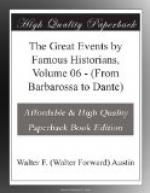Grim interposed his arm, which was broken, but the force of the stroke bore away the Primate’s cap and wounded him on the crown. As he felt the blood trickling down his face he joined his hands and bowed his head saying, “In the name of Christ and for the defence of his Church I am ready to die.” In this posture, turned toward his murderers, without a groan and without a motion, he awaited a second stroke, which threw him on his knees; the third laid him on the floor at the foot of St. Bennet’s altar. The upper part of his skull was broken in pieces, and Hugh of Horsea, planting his foot on the Archbishop’s neck, with the point of his sword drew out the brains and strewed them over the pavement![30]
Thus at the age of fifty-three perished this extraordinary man, a martyr to what he deemed to be his duty, the preservation of the immunities of the Church. The moment of his death was the triumph of his cause. His personal virtues and exalted station, the dignity and composure with which he met his fate, the sacredness of the place where the murder was perpetrated, all contributed to inspire men with horror for his enemies and veneration for his character. The advocates of the “customs” were silenced. Those who had been eager to condemn, were now the foremost to applaud, his conduct; and his bitterest foes sought to remove from themselves the odium of having been his persecutors. The cause of the Church again flourished: its liberties seemed to derive new life and additional vigor from the blood of their champion.
THE PEACE OF CONSTANCE SECURES THE LIBERTIES OF THE LOMBARD CITIES
A.D. 1183
ERNEST F. HENDERSON
Frederick, Duke of Swabia, and his brother Conrad, Duke of the Franks, grandsons of Henry IV, were the hereditary and dynastic successors to the throne of Germany, when with the death of Henry V in 1125 the male line of the Franconian dynasty ended. The brothers demanded the assertion of the elective right in the imperial office, and Lothair, Duke of Saxony, was elected emperor of Germany.
Lothair died in 1138. His son-in-law, the Wolf or Welf nobleman, Henry the Proud, Duke of Bavaria, whom Lothair had nominated as his successor, was opposed by the Swabian faction—also known as the Waiblingen faction—from the Franconian village in which the Swabian duke Frederick was born.
The Waiblingen faction elected as emperor of Germany Conrad the Crusader, in whom began the Hohenstaufen dynasty, so named from the Swabian family seat on the lofty Staufen hill rising from the Rems River.
From this event dates the strife of the Welfs and Waiblingens, who in Italy became known as Guelfs and Ghibellines. The chief opponents in the long strife that ensued were the Guelf dukes, Henry the Proud and Henry the Lion,




